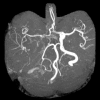Unilateral antegrade selective cerebral perfusion in aortic surgery: clinical outcomes at different levels of hypothermia
- PMID: 19794975
- PMCID: PMC2752760
- DOI: 10.3346/jkms.2009.24.5.807
Unilateral antegrade selective cerebral perfusion in aortic surgery: clinical outcomes at different levels of hypothermia
Abstract
Although unilateral antegrade selective cerebral perfusion (UASCP) is considered a safe cerebral protection strategy during aortic surgery, an optimum temperature remains to be defined. This study compared outcomes in patients undergoing UASCP at either <24 or > or =24. Between 2000 and 2007, 104 consecutive patients underwent aortic surgery using UASCP. Patients were divided into two groups according to systemic temperature: group A comprised 64 patients undergoing deep hypothermia (<24); and group B comprised 40 patients undergoing moderate hypothermia (> or =24). Both groups were similar in terms of the extent of aortic replacement and mean UASCP time. The total cardiopulmonary bypass time and aortic cross clamp time were longer in group A. Both groups were similar in terms of 30-day mortality rate (9.4% group A, 10.0% group B), and in terms of temporary (6.7% group A, 7.7% group B) and permanent (11.3% group A, 2.6% group B) neurological deficits. Multivariate analysis showed preoperative shock status was a risk factor for in-hospital mortality, and a preoperative history of a cerebral incident was a risk factor for permanent neurological deficit. UASCP under moderate hypothermia is a relatively safe and effective cerebral protective strategy during aortic surgery.
Keywords: Aorta, Thoracic; Cerebrovascular Circulation; Hypothermia.
Figures
Similar articles
-
Antegrade selective cerebral perfusion in thoracic aorta surgery: safety of moderate hypothermia.Eur J Cardiothorac Surg. 2007 Apr;31(4):618-22. doi: 10.1016/j.ejcts.2006.12.032. Epub 2007 Jan 23. Eur J Cardiothorac Surg. 2007. PMID: 17254793
-
Selective antegrade cerebral perfusion via right axillary artery cannulation reduces morbidity and mortality after proximal aortic surgery.J Thorac Cardiovasc Surg. 2009 Nov;138(5):1081-9. doi: 10.1016/j.jtcvs.2009.07.045. Epub 2009 Sep 15. J Thorac Cardiovasc Surg. 2009. PMID: 19758609
-
Moderate hypothermia during aortic arch surgery is associated with reduced risk of early mortality.J Thorac Cardiovasc Surg. 2013 Sep;146(3):662-7. doi: 10.1016/j.jtcvs.2013.03.004. Epub 2013 Apr 1. J Thorac Cardiovasc Surg. 2013. PMID: 23558304
-
Is moderate hypothermic circulatory arrest with selective antegrade cerebral perfusion superior to deep hypothermic circulatory arrest in elective aortic arch surgery?Interact Cardiovasc Thorac Surg. 2016 Sep;23(3):462-8. doi: 10.1093/icvts/ivw124. Epub 2016 May 21. Interact Cardiovasc Thorac Surg. 2016. PMID: 27209532 Review.
-
[Brain Protection for Shaggy Aorta During Aortic Arch Surgery].Kyobu Geka. 2017 Jul;70(8):571-577. Kyobu Geka. 2017. PMID: 28790269 Review. Japanese.
Cited by
-
Brief review on systematic hypothermia for the protection of central nervous system during aortic arch surgery: a double-sword tool?J Cardiothorac Surg. 2011 Nov 20;6:153. doi: 10.1186/1749-8090-6-153. J Cardiothorac Surg. 2011. PMID: 22099391 Free PMC article.
References
-
- Griepp RB, Stinson EB, Hollingsworth JF, Buehler D. Prosthetic replacement of aortic arch. J Thorac Cardiovasc Surg. 1975;70:1051–1053. - PubMed
-
- Ueda Y, Miki S, Kusuhara K, Okita Y, Tahata T, Yamanaka K. Surgical treatment of aneurysms or dissections involving the ascending aorta and aortic arch, utilizing circulatory arrest and retrograde cerebral perfusion. J Cardiovasc Surg (Torino) 1990;31:553–558. - PubMed
-
- Kazui T, Kimura N, Yamada O, Komatsu S. Surgical outcome of aortic arch aneurysms using selective antegrade perfusion. Ann Thorac Surg. 1994;57:904–911. - PubMed
-
- Griepp RB. Cerebral proctection during aortic arch surgery. J Thorac Cardiovasc Surg. 2001;121:425–427. - PubMed
-
- Di Eusanio M, Schepens MA, Morshuis WJ, Dossche KM, Di Bartolomeo R, Pacini D, Pierangeli A, Kazui T, Ohkura K, Washiyama N. Brain protection using antegrade selective cerebral perfusion: a multicenter study. Ann Thorac Surg. 2003;76:1181–1189. - PubMed
MeSH terms
LinkOut - more resources
Full Text Sources


